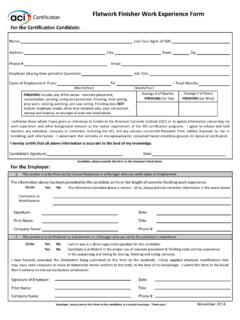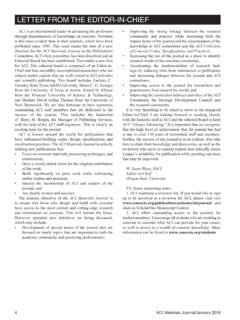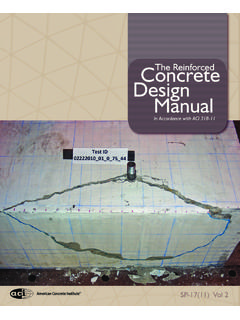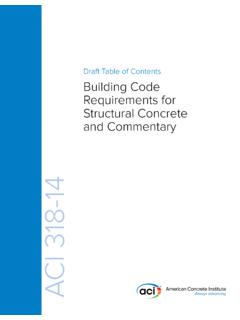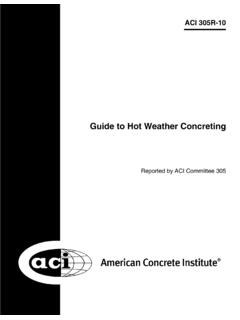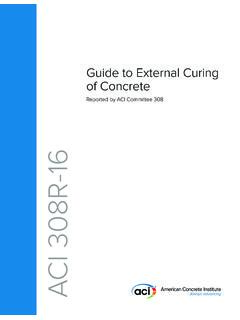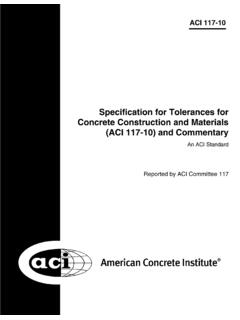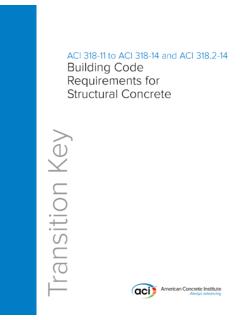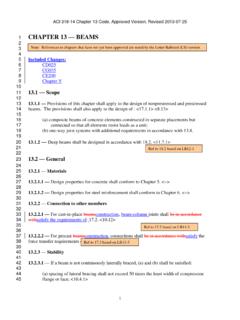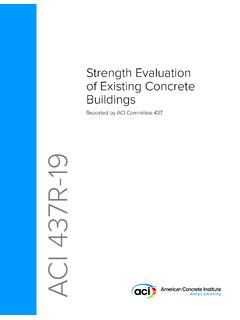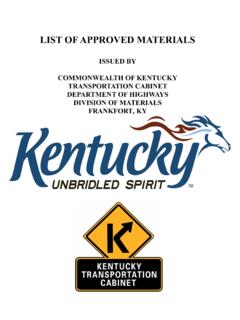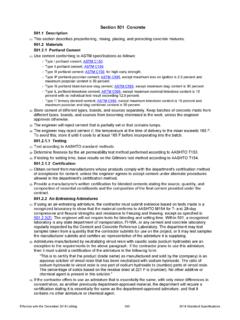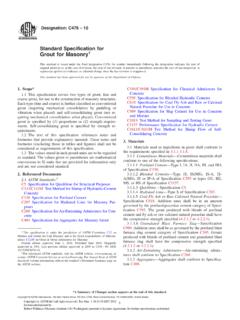Transcription of ACI Concrete Terminology
1 ACI CT-13 ACI Concrete TerminologyAn ACI STANDARDF irst PrintingJanuary 2013 ACI Concrete TerminologyCopyright by the American Concrete Institute, Farmington Hills, MI. All rights reserved. This material may not be reproduced or copied, in whole or part, in any printed, mechanical, electronic, film, or other distribution and storage media, without the written consent of technical committees responsible for ACI committee reports and standards strive to avoid ambiguities, omissions, and errors in these documents. In spite of these efforts, the users of ACI documents occasionally find information or requirements that may be subject to more than one interpretation or may be incomplete or incorrect.
2 Users who have suggestions for the improvement of ACI documents are requested to contact ACI via the errata website at Proper use of this document includes periodically checking for errata for the most up-to-date committee documents are intended for the use of individuals who are competent to evaluate the significance and limitations of its content and recommendations and who will accept responsibility for the application of the mate-rial it contains. Individuals who use this publication in any way assume all risk and accept total responsibility for the application and use of this information in this publication is provided as is without warranty of any kind, either express or implied, includ-ing but not limited to, the implied warranties of merchantability, fitness for a particular purpose or and its members disclaim liability for damages of any kind, including any special, indirect, incidental, or con-sequential damages, including without limitation, lost revenues or lost profits.
3 Which may result from the use of this is the responsibility of the user of this document to establish health and safety practices appropriate to the specific circumstances involved with its use. ACI does not make any representations with regard to health and safety issues and the use of this document. The user must determine the applicability of all regulatory limitations before applying the document and must comply with all applicable laws and regulations, including but not limited to, United States Occupational Safety and Health Administration (OSHA) health and safety by governmental representatives in the work of the American Concrete Institute and in the develop-ment of Institute standards does not constitute governmental endorsement of ACI or the standards that it information.
4 ACI documents are available in print, by download, on CD-ROM, through electronic subscription, or reprint and may be obtained by contacting ACI standards and committee reports are gathered together in the annually revised ACI Manual of Concrete Practice (MCP).American Concrete Institute38800 Country Club DriveFarmington Hills, MI : 248-848-3700 Fax: Concrete Institute Advancing Concrete knowledge1 ACI Concrete Terminology A/F ratio the molar or mass ratio of aluminum oxide (Al2O3) to iron oxide (Fe2O3), as in portland cement. Abrams law a rule stating that, with given Concrete materials and conditions of test, the ratio of the amount of water to the amount of the cement in the mixture determines the strength of the Concrete , provided the mixture is of a workable consistency.
5 (See also water-cement ratio.) abrasion damage wearing away of a surface by rubbing and friction. (See also cavitation damage and erosion.) abrasion resistance ability of a surface to resist being worn away by rubbing and friction. absolute volume (1) in the case of solids, the displacement volume of particles themselves, including their permeable and impermeable voids, but excluding space between particles; (2) in the case of fluids, their volume. absorbed moisture moisture that has entered the permeable pores of a solid and has physical properties not substantially different from ordinary water at the same temperature and pressure.
6 (See also absorption.) absorbed water see absorbed moisture absorption (1) the process by which a liquid is drawn into and tends to fill permeable voids in a porous solid body; (2) the increase in mass of a porous solid body resulting from the penetration of a liquid into its permeable voids. abutment (1) in bridges, the end foundation that is typically constructed with Concrete that supports the superstructure of the bridge; (2) in dams, the side of the gorge or bank of the stream against which a dam abuts. accelerating admixture an admixture that causes an increase in the rate of hydration of the hydraulic cement and thus shortens the time of setting, increases the rate of strength development, or both.
7 Acceleration increase in rate of natural progress of setting or hardening of Concrete . (See also accelerating admixture.) accelerator see accelerating admixture accidental air see entrapped air (preferred term) acid etching the removal of a cementitious surface through controlled dissolution to expose sand or aggregates, roughen a smooth cementitious surface in preparation for cementitious coating material application, or create art, create design, or create an architectural finish. acrylic resin one of a group of thermoplastic resins formed by polymerizing the esters or amides of acrylic acid used to make polymer-modified Concrete and polymer concretes.
8 Active crack a crack whose width changes with time. addition a material that is interground or blended in limited amounts into a hydraulic cement during manufacture either as a processing addition to aid in manufacturing and handling the cement or as a functional addition to modify the use properties of the finished product. additive a substance added to another in relatively small amounts to impart or improve desirable properties or suppress undesirable properties. adhesion the state in which two surfaces are held together by interfacial effects that may consist of molecular forces, interlocking action, or both. adhesives the group of materials used to join or bond similar or dissimilar materials, for example, in Concrete work, the epoxy resins.
9 Adiabatic a condition in which heat neither enters or leaves a system. admixture a material other than water, aggregates, cementitious materials, and fiber reinforcement, used as an ingredient of a cementitious mixture to modify its freshly mixed, setting, or hardened properties and that is added to the batch before or during its mixing. adsorbed water water held on surfaces of a material by electrochemical forces and having physical properties substantially different from those of absorbed water or chemically combined water at the same temperature and pressure. (See also adsorption.) adsorption (1) development of a higher concentration of a substance at the surface of either a liquid or solid, such as cement, cement paste, or aggregates, than exists in the bulk of the medium; (2) the process by which a substance is adsorbed.
10 (See also adsorbed water.) advancing-slope grouting a method of grouting by which the front of a mass of grout is caused to move horizontally through preplaced aggregate by use of a suitable grout injection sequence. advancing-slope method a method of placing Concrete , as in tunnel linings, in which the face of the fresh Concrete is not vertical and moves forward as Concrete is placed. aerated Concrete see cellular Concrete and foamed Concrete afwillite a mineral with composition 3 CaO 2 SiO2 3H2O occurring naturally in South Africa, Northern Ireland, and California, and artificially in some hydrated portland cement mixtures.
